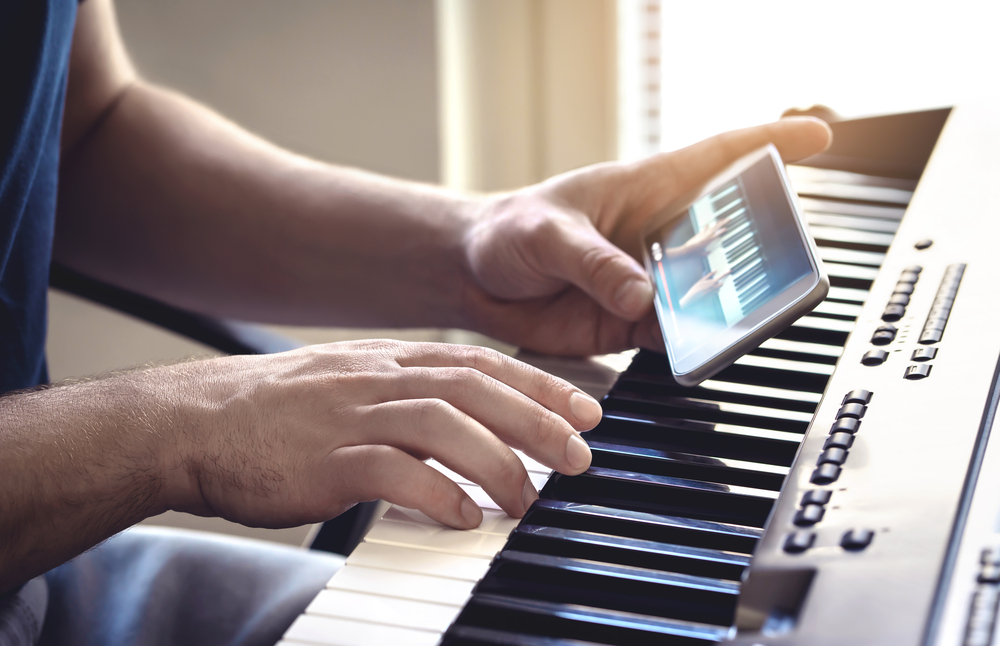
If you’re just starting out on the piano (or you’ve been practicing for a while and have reached a plateau), you may wonder, “How to learn piano faster?”
Learning the piano might seem challenging, but you don’t need to spend years trying to get good.
Unfortunately, many people take long and tedious journeys that don’t lead to where they wanted to go.
If you do it right, this process may be much quicker than you think.
Let’s dive into the fastest ways to learn the piano, along with some valuable tips and tricks.
Table Of Contents Best Way To Learn The Piano FasterLearn OnlineBest Way To Learn a Song FasterTips and Tricks To Improve PracticeMistakes Beginner Pianists Make That Slows ProgressMistake #1: Using Too Much Sustain PedalMistake #2: Looking Down At The Keys Too MuchMistake #3: Only Practicing OccasionallyEverybody Wants To Play Piano Faster (Here’s How)
Best Way To Learn The Piano Faster
So, you want to learn the piano quickly? Many people will tell you it’s a process that takes years and years to accomplish. For some, that can be a little discouraging. In 5 years, you might not even be interested in playing anymore. That’s why it’s highly beneficial to use the most efficient learning method.
Learn Online

Wait a second. Not piano lessons? Surprisingly, no. Though piano lessons can be an extremely effective way to improve, it’s not necessarily the fastest. With these lessons, you learn once a week. The teacher might give you plenty of material to work on, but you only get to spend 30 to 60 minutes with them.
The internet has millions of piano tutorials and lessons on Youtube and other websites. You can spend as much time as you please, learning any piano technique you desire. No matter the song you wish to learn, there’s likely a video tutorial.
On top of Youtube, there are endless online piano learning programs. Many of them allow you to go at your own pace, which is convenient. If you put your mind to it, there’s no real limit to how fast you can learn the piano.
Of course, it doesn’t happen overnight, but it certainly doesn’t need to take years. With the combination of a desire to learn and efficient use of online resources, you could be playing well in a month or two.
Best Way To Learn a Song Faster
There’s a science to learning anything faster. Some people think it’s practicing nonstop for hours each day, while others might frequently learn both hands separately. The real way to learn songs faster is through mindful and efficient practice sessions.
Some pianists brag about practicing 3, 4, and 5 hours a day. Contrary to popular belief, a strict practice routine like this doesn’t always yield great results. Many of those hours become heedless and wandering. You can actually get the same, if not more, improvement with 30 minutes to an hour of focused and mindful practice every day. Here’s what an efficient practice session might look like:
The Warmup: 10 Minutes
In the beginning, it’s always great to warm up your mind and your fingers. It’s better to do this by playing a song you already know since this engages your mind more than exercises. But, if you don’t know any songs yet, there are plenty of warm-up exercises you can follow online. You can find tons of helpful videos that go through both beginner and advanced exercises. Once your fingers are warmed up, it’s time for the next stage.
Main Goals: 20 Minutes
At this time, you should jump straight into your primary focus of the day. This could include working on a song, practicing technique, playing with a metronome, learning sheet music, practicing more finger exercises, etc.
Using the internet can be the fastest way to improve, but it can also be a distraction. During the practice session, it’s vital to not become distracted by social media or the internet. Those things can create an inattentive practice session. The goal of this 20-minute slot is to improve on at least one thing. You’ll be surprised at how quickly a little progress adds up in a few weeks. Let’s dive into the next practice stage.
Take a Break: 5 Minutes
You may not have expected this in a practice routine, but taking a quick break can work wonders for you. Think of this time as a quick mental refuel. With a fresh mind, you can come back to the piano and be more productive than you would’ve been. What you do during this time is your choice, but there’s something you should keep in mind. Once again, it’s social media.
Studies have shown that social networking apps can make you more stressed and fog your mind during breaks. There may be better things to do that won’t distract you as much. Another study by Princeton University showed that a little exercise is one of the best things to do during a break.
Obviously, 5 minutes isn’t enough time for the intense exercise. Instead, you might walk around the house or, even better, stretch. Over time, a poor posture on the piano bench can lead to back pains.
If you want to be as pro-active as possible with this time, try doing some back stretches. Let’s move on to the final practice stage.
Change It Up: 25 Minutes
For this last section of practice, change it up a little. If you still want to work on your primary goal, that’s also appropriate. But, if you change it up, there are many options. One of them is improvising.
Lots of pianists enjoy taking time to freely improvise with anything that comes to mind. This can be a great way to spark your creativity and express yourself through music. However, if you don’t feel comfortable improvising, you could do things like practicing chords, chord progressions, sheet music, and more.
If you implement a plan like this, you could improve much faster than you thought possible. This plan relies on setting 1-2 goals for each day, big or small, and tackling them. If you’ve never touched a piano, this plan could have you playing some of your favorite songs in as little as a month.
Tips and Tricks To Improve Practice
Here are some valuable tips and tricks for an excellent practice session:
- Break music into small sections
- Practice slow
- Practice correct fingering
- Frequently listen to the music you’re learning
- Record yourself playing
- Make a game plan
- Find a practice routine
- Understand that progress takes time
Mistakes Beginner Pianists Make That Slows Progress
Mistake #1: Using Too Much Sustain Pedal
The sustain pedal: A device that some pianists use to try and cover up mistakes.
One of the biggest mistakes that beginners make is using the sustain pedal too much. This pedal sustains the sound even when you’re not pressing down the note anymore. With the pedal, pianists can play very beautifully, but many beginners get carried away and believe it covers up their mistakes. The music then blends together, becoming unappealing and conflicting.
Mistake #2: Looking Down At The Keys Too Much
This mistake happens when reading sheet music. Sometimes it’s hard to balance between looking at the music and the keys. But, for the most part, you should be looking at the sheet music 90% of the time. Once your fingers become relatively comfortable with the keys, this feat isn’t as hard as it sounds. With most physical activity, we develop muscle memory. So, when you read sheet music, trust your fingers and try not to look at them. You may be surprised at how well you can remember where the notes are.
Mistake #3: Only Practicing Occasionally
It can be very challenging to learn the piano if you only practice when you feel like it. Even if you make some improvements, it won’t remain if weeks go by until the next practice session. If not every day, try practicing 3-4 times a week. These sessions don’t need to be very long, but consistency will be your friend in the end.
